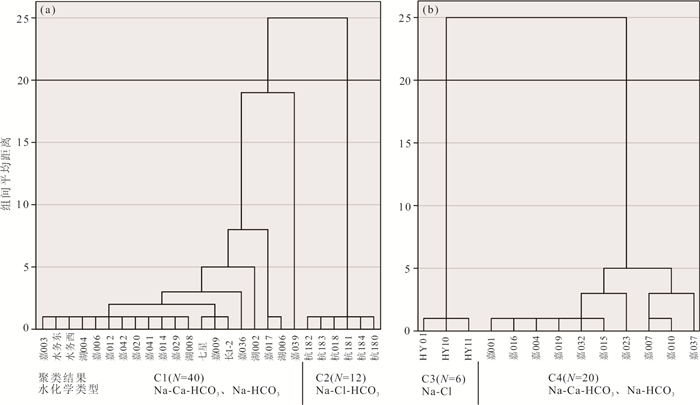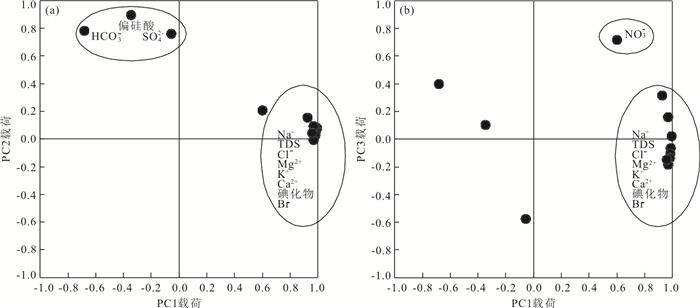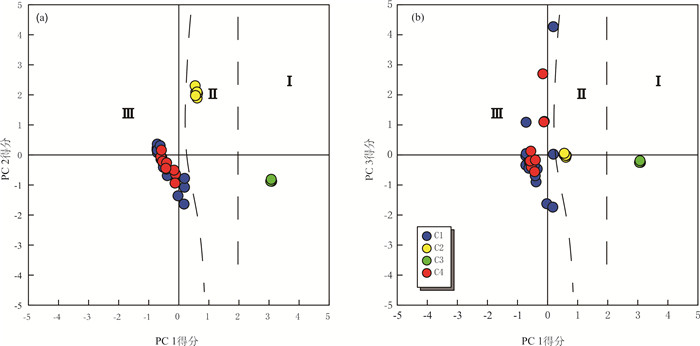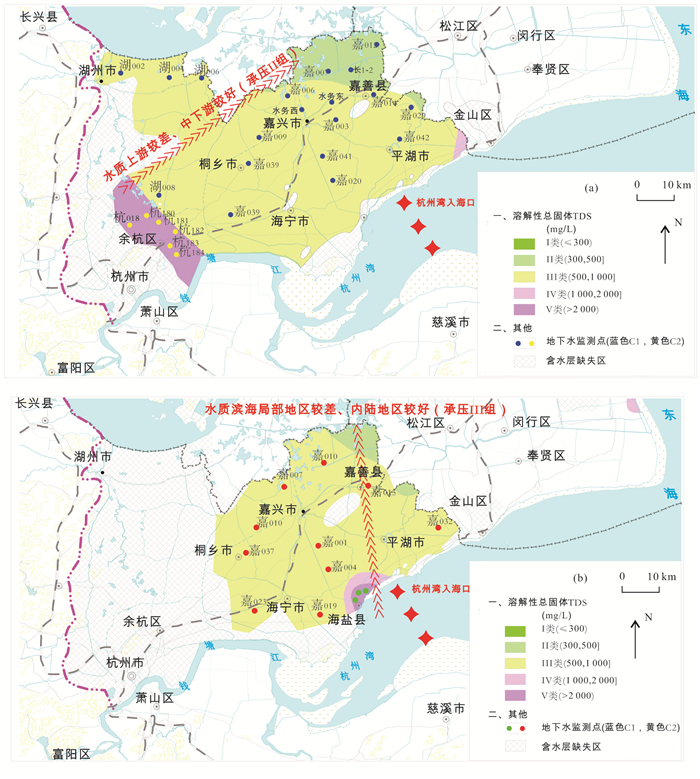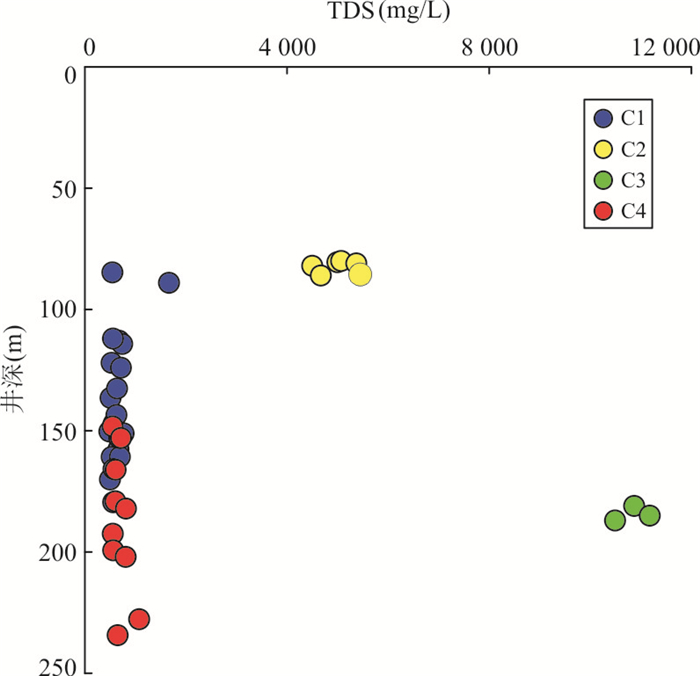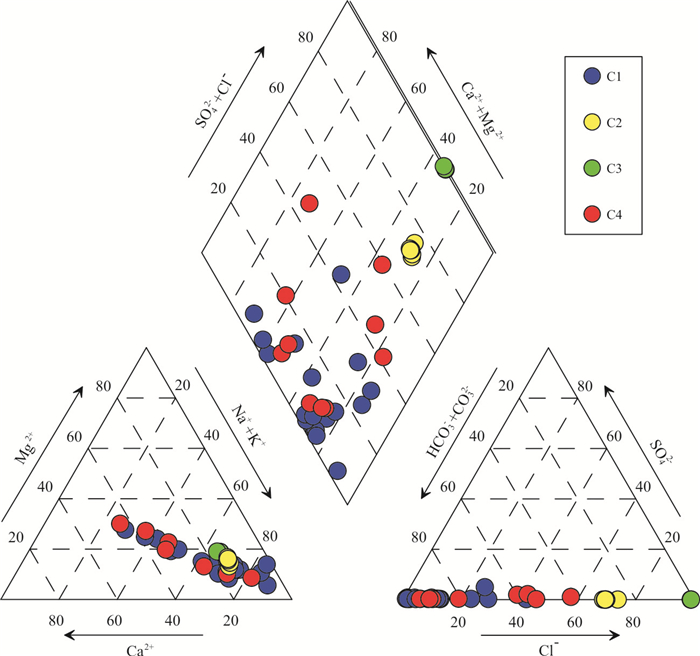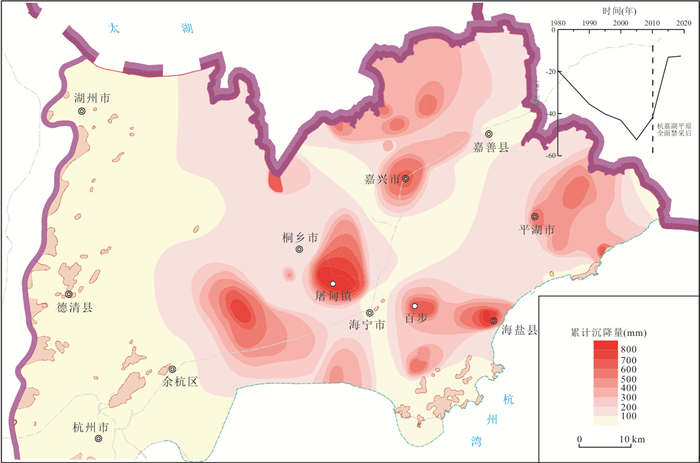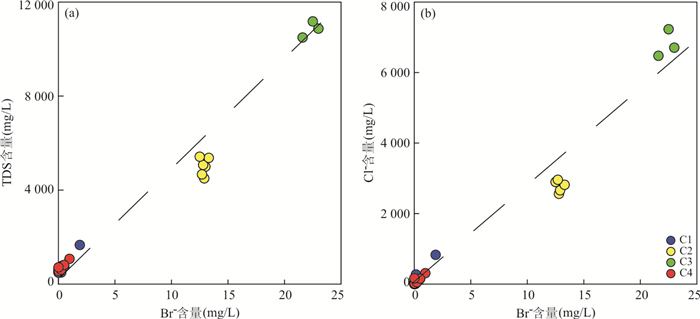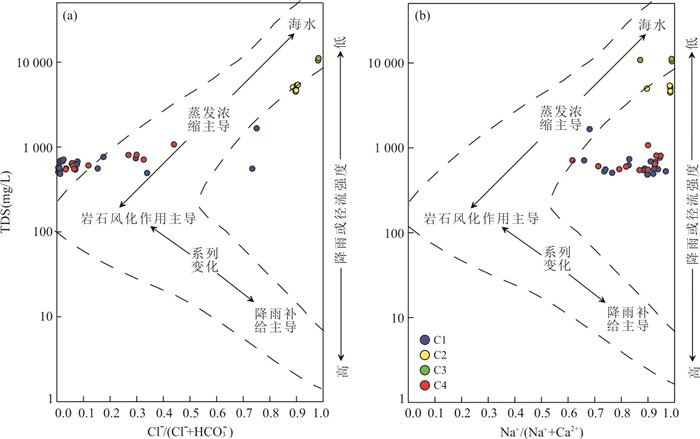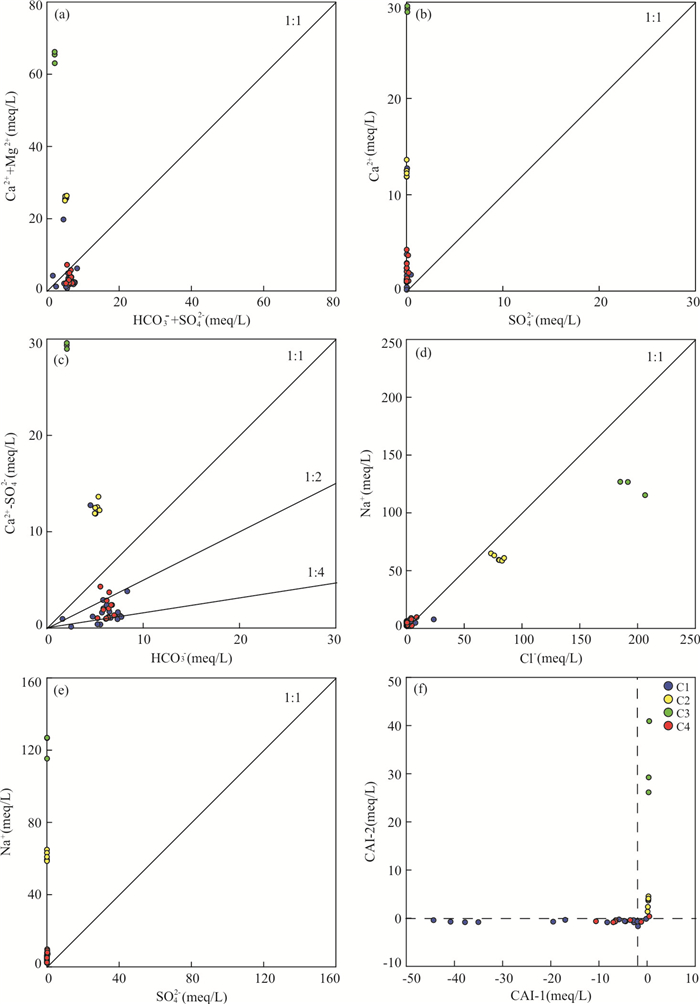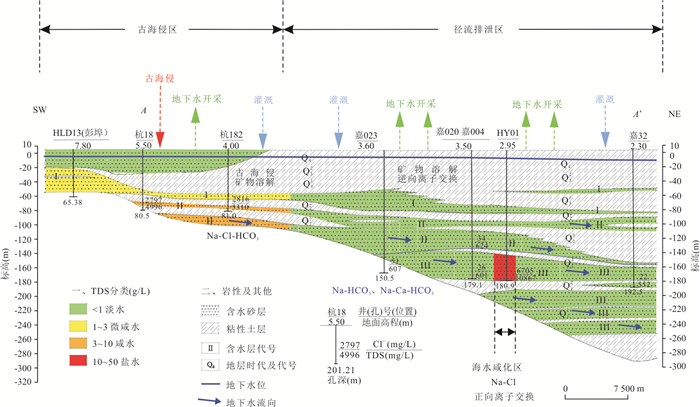Hydrogeochemical Evolution of Groundwater Flow System in the Typical Coastal Plain: A Case Study of Hangjiahu Plain
-
摘要: 滨海平原地区地下水流系统水化学场演化过程复杂,同时受古海侵咸化以及现代人类活动影响,当前对其专门分析的研究较少.以杭嘉湖平原为例,综合运用多元统计和水化学分析方法,对采集的78个深层孔隙承压水样品水化学数据进行解译.研究表明:区内水化学分区可划分为“古海侵区”、“径流排泄区”、“海水咸化区”,水化学类型依次为Na-Cl-HCO3型、Na-HCO3和Na-Ca-HCO3型、Na-Cl型.深层地下水化学成因包括“海水入侵和离子交换”、“天然矿物溶解”、“人类活动”.滨海平原区地下水流系统无明显级次划分,地下水化学场演化先后经历原生淡水形成、古海侵咸化、人为超采和现代海水入侵3个阶段,当前不同程度的“人类活动”已取代自然过程成为驱动区内地下水流系统、尤其是水化学场演化的主要因素.Abstract: The hydrogeochemical evolution of groundwater flow system in the coastal plainis a complicated process which is influenced by both ancientseawater intrusion and modern anthropogenic activities. However, at present few of previous studies specially investigated on it.In this study, taking the Hangjiahu Plain as an example, the multivariate statistics and hydrochemical analysis methods are used to interpret the hydrochemical data of 78 water samples from deep confined aquifers. Results show that hydrogeochemicalzones of this typical coastal plain can be classified as the ancient seawater intrusionzone, salinized zone and runoff-discharge zone, with the hydrochemical type of Na-Cl-HCO3, Na-HCO3and Na-Ca-HCO3, and Na-Cl, respectively.The dominant factors of groundwaterhydrogeochemical evolution of this coastal plain were seawater invasion and ion exchange, natural rock dissolution and anthropogenic activities. No obvious groundwater flow system hierarchy was foundin the coastal plain. There is a typical pattern of hydrogeochemical evolutionoccurring. Such evolutionis constituted with the following three stages: (1) the formation stage of original fresh water, (2) the salinization stage by ancientseawater invasion, and (3) the modernseawater invasion stage induced by human over pumping. Moreover, anthropogenic activitieshave replaced natural progresses and become the dominant factor on coastal hydrogeochemical evolution.
-
Key words:
- hydrogeochemical evolution /
- coastal plain /
- Hangjiahu Plain /
- groundwater
-
图 9 杭嘉湖平原地表累计沉降量等值线图(截至2018年)
根据赵建康等(2006)结果修改
Fig. 9. Contour map of the surfacecumulative subsidence in Hangjiahu Plain (by the year of 2018)
表 1 杭嘉湖平原深层地下水监测井含水层位置和深度
Table 1. Aquifers and depths of the sampling wells in Hangjiahu Plain
序号 监测站点编号 含水层代号 井深(m) 1 嘉041 Ⅱ 136.45 2 嘉003 Ⅱ 157.57 3 七星 Ⅱ 160.80 4 嘉006 Ⅱ 132.57 5 嘉009 Ⅱ 179.51 6 水务西 Ⅱ 112.89 7 水务东 Ⅱ 160.77 8 嘉012 Ⅱ 147.00 9 嘉014 Ⅱ 122.00 10 嘉020 Ⅱ 143.50 11 嘉017 Ⅱ 170.10 12 长1-2 Ⅱ 150.30 13 嘉036 Ⅱ 153.00 14 嘉039 Ⅱ 151.10 15 嘉042 Ⅱ 165.80 16 嘉029 Ⅱ 114.20 17 嘉032 Ⅲ 192.47 18 湖002 Ⅱ 89.00 19 湖004 Ⅱ 124.00 20 湖006 Ⅱ 112.00 21 湖008 Ⅱ 84.70 22 嘉001 Ⅲ 199.30 23 嘉007 Ⅲ 227.70 24 嘉010 Ⅲ 202.00 25 嘉015 Ⅲ 234.30 26 嘉004 Ⅲ 179.10 27 嘉016 Ⅲ 148.20 28 嘉023 Ⅲ 166.08 29 嘉037 Ⅲ 182.09 30 嘉019 Ⅲ 152.99 31 HY01 Ⅲ 180.99 32 HY10 Ⅲ 187.00 33 HY11 Ⅲ 185.00 34 杭018 Ⅱ 80.50 35 杭180 Ⅱ 80.00 36 杭181 Ⅱ 82.00 37 杭182 Ⅱ 81.00 38 杭183 Ⅱ 85.00 39 杭184 Ⅱ 86.00 表 2 地下水样品主要指标检测方法及测试精度
Table 2. Test method and accuracy of the main index of groundwater samples
指标 方法 仪器(型号编号) 方法检出限(mg/L) 实验室测试精度 TDS 重量法 ME 204E电子天平(B341876889) 4.00 0.36% K+ 电感耦合等离子体发射光谱法 Leeman Prodigy全谱直读光谱仪(4015) 0.10 5.19% Na+ 电感耦合等离子体发射光谱法 Leeman Prodigy全谱直读光谱仪(4015) 2.00 1.39% Ca2+ 电感耦合等离子体发射光谱法 Leeman Prodigy SN4005电感耦合等离子体发射光谱仪(3104) 3.00 1.34% Mg2+ 电感耦合等离子体发射光谱法 Leeman Prodigy SN4005电感耦合等离子体发射光谱仪(3104) 3.00 6.78% Cl- 离子色谱法 DIONEX AQUION离子色谱仪(180123239) 2.00 0.26% SO42- 离子色谱法 DIONEX AQUION离子色谱仪(180123239) 1.00 0.67% HCO3- 滴定法 / 3.00 0.41% NO3- 离子色谱法 DIONEX AQUION离子色谱仪(180123240) 0.20 1.13% Br- 离子色谱法 DIONEX AQUION离子色谱仪(180123239) 0.01 2.13% 偏硅酸 硅钼蓝(黄)比色法 Analytik jena specord 50plus紫外可见分光光度计(233H1475C) 2.00 0.50% 碘化物 火焰原子吸收分光光度法 PerkinElmer Analyst 400原子吸收光谱仪(B3150080) 0.01 4.80% 表 3 地下水样品中水化学组分统计结果(N=78)
Table 3. Statistics of groundwater hydrogeochemistry (N=78)
水化学指标 承压Ⅱ层(N=52) 承压Ⅲ层(N=26) 最小值(mg/L) 最大值(mg/L) 平均值(mg/L) 标准差(mg/L) 变异系数CV(%) 最小值(mg/L) 最大值(mg/L) 平均值(mg/L) 标准差(mg/L) 变异系数CV(%) TDS 484.0 5 420.0 1661.8 370.0 22% 547.0 11 176.1 3 035.1 1 236.0 41% K+ 1.1 24.8 7.6 1.8 24% 1.6 29.8 9.0 3.2 35% Na+ 51.8 1 492.7 413.6 108.7 26% 56.7 2 918.0 746.5 329.9 44% Ca2+ 2.7 272.7 88.8 19.8 22% 20.0 591.9 168.5 66.3 39% Mg2+ 4.5 172.3 51.1 12.3 24% 10.2 439.3 112.6 49.8 44% Cl- 1.9 2 959.3 705.2 230.1 33% 13.0 7 228.2 1 640.7 817.7 50% SO42- 0.9 22.2 2.0 0.4 20% 1.0 11.0 3.9 1.0 26% HCO3- 99.0 509.0 351.4 17.7 5% 126.0 426.0 320.1 31.6 10% NO3- 0.0 11.9 3.5 0.9 25% 0.0 3.5 1.4 0.3 22% Br- 0.0 13.3 3.1 1.1 34% 0.0 23.0 5.4 2.7 50% 偏硅酸 0.1 64.5 26.3 2.4 9% 8.4 66.0 25.9 4.1 16% 碘化物 0.0 7.0 1.5 0.5 35% 0.0 6.2 1.4 0.7 51% 表 4 聚类分析各类型地下水水化学组分(平均值)统计
Table 4. Groundwater hydrogeochemistry of each cluster (mean value)
水化学指标 承压Ⅱ层 承压Ⅲ层 C1(N=40, mg/L) C2(N=12, mg/L) C3(N=6, mg/L) C4(N=20, mg/L) TDS 659.3 5 003.5 10 844.3 692.4 K+ 2.7 23.9 28.9 3.0 Na+ 116.7 1 403.4 2 828.3 121.9 Ca2+ 40.8 248.9 586.1 43.2 Mg2+ 18.5 159.7 427.0 18.3 Cl- 82.3 2 781.6 6 802.5 92.2 SO42- 2.4 1.0 4.1 3.8 HCO3- 361.9 316.4 126.3 378.2 NO3- 1.2 11.0 2.7 1.0 Br- 0.2 12.9 22.4 0.2 偏硅酸 25.6 28.6 8.7 31.0 碘化物 0.1 6.4 5.9 0.1 表 5 旋转后的因子载荷矩阵及其方差贡献率统计
Table 5. Principal components loading and explained variance for three components with varimax normalized rotation
水化学指标 PC1 PC2 PC3 Br- 0.994 0.079 0.021 Na+ 0.988 0.062 -0.066 TDS 0.984 0.053 -0.106 Cl- 0.982 0.028 -0.136 Mg2+ 0.970 -0.007 -0.184 K+ 0.969 0.093 0.159 Ca2+ 0.960 0.044 -0.148 碘化物 0.926 0.155 0.315 偏硅酸 -0.346 0.896 0.102 HCO3- -0.681 0.781 0.398 SO42- -0.056 0.761 -0.577 NO3- 0.601 0.207 0.717 特征值 8.51 1.62 1.23 方差贡献率(%) 70.88 13.49 10.25 累计方差贡献率(%) 70.88 84.37 94.62 注:KMO=0.838,因子载荷大于0.7的指标用黑体表示. -
Böhlke, J.K., Denver, J.M., 1995. Combined Use of Groundwater Dating, Chemical, and Isotopic Analyses to Resolve the History and Fate of Nitrate Contamination in Two Agricultural Watersheds, Atlantic Coastal Plain, Maryland. Water Resources Research, 31(9): 2319-2339. https://doi.org/10.1029/95wr01584 Barlow, P.M., Reichard, E.G., 2010. Saltwater Intrusion in Coastal Regions of North America. Hydrogeology Journal, 18(1): 247-260. https://doi.org/10.1007/s10040-009-0514-3 Cloutier, V., Lefebvre, R., Therrien, R., et al., 2008. Multivariate Statistical Analysis of Geochemical Data as Indicative of the Hydrogeochemical Evolution of Groundwater in a Sedimentary Rock Aquifer System. Journalo f Hydrology, 353(3/4): 294-313. https://doi.org/10.1016/j.jhydrol.2008.02.015 Davis, J.C., 1973. Statistics and Data Analysis in Geology. John Wiley and Sons Inc, New York. El Alfy, M., Lashin, A., Abdalla, F., et al., 2017. Assessing the Hydrogeochemical Processes Affecting Groundwater Pollution in Arid Areas Using an Integration of Geochemical Equilibrium and Multivariate Statistical Techniques. Environmental Pollution, 229(2): 760-770. https://doi.org/10.1016/j.envpol.2017.05.052 Gibbs, R.J., 1970. Mechanisms Controlling World Water Chemistry. Science, 170(3962): 1088-1090. https://doi.org/10.1126/science.170.3962.1088 Güler, C., Thyne, G.D., McCray, J.E., et al., 2002. Evaluation of Graphical and Multivariate Statistical Methods for Classification of Water Chemistry Data. Hydrogeology Journal, 10(4): 455-474. https://doi.org/10.1007/s10040-002-0196-6 Han, D.M., Song, X.F., Currell, M.J., et al., 2014. Chemical and Isotopic Constraints on Evolution of Groundwater Salinization in the Coastal Plain Aquifer of Laizhou Bay, China. Journal of Hydrology, 508(5): 12-27. https://doi.org/10.1016/j.jhydrol.2013.10.040 Jia, J.Y., Jiang, Y.H., Zhou, X., et al., 2011. A Preliminary Study on Hydrochemical and Isotope Characteristics of Groundwater in Hangjiahu Area. Resources Survey and Environment, 32(2): 150-156 (in Chinese with English abstract). http://en.cnki.com.cn/Article_en/CJFDTOTAL-HSDZ201102010.htm Jia, Y.F., Xi, B.D., Jiang, Y.H., et al., 2018. Distribution, Formation and Human-Induced Evolution of Geogenic Contaminated Groundwater in China: A Review. Science of The Total Environment, 643(22): 967-993. https://doi.org/10.1016/j.scitotenv.2018.06.201 Liu, S.X., Shen, H.Z., Zhao, J.K., et al., 2006. Geo-Environmental Effects since the Beginning of Groundwater Exploitation Restriction in the ZhejiangCoastal Plain. Journal of Geological Hazards and Environment Preservation, (2): 39-46 (in Chinese with English abstract). http://en.cnki.com.cn/Article_en/CJFDTOTAL-DZHB201302007.htm Lin, X.B., 2007. Study on the Groundwater Environmental Isotopes in theHangjiahu Region(Dissertation). Chinese Academy of Geological Sciences, Beijing (in Chinese with English abstract). Liang, X., Zhang, R.Q., Jin, M.G., 2015. GroundwaterFlow System: Theory, Application and Investigation. Geology Press, Beijing(in Chinese). Li, C.S., Wu, X.C., Sun, B., et al., 2018. Hydrochemical Characteristics and Formation Mechanism of Geothermal Water in Northern Ji'nan. Earth Science, 43(S1): 317-329 (in Chinese with English abstract). http://en.cnki.com.cn/Article_en/CJFDTotal-DQKX2018S1027.htm Mandilaras, D., Lambrakis, N., Stamatis, G., 2008. The Role of Bromide and Iodide Ions in the Salinization Mapping of the Aquifer of Glafkos River Basin (Northwest Achaia, Greece). Hydrological Processes, 22(5): 611-622. https://doi.org/10.1002/hyp.6627 Ma, J.Z., Ding, Z.Y., Edmunds, W.M., et al., 2009. Limits to Recharge of Groundwater from Tibetan Plateau to the Gobi Desert, Implications for Water Management in the Mountain Front. Journal of Hydrology, 364(1/2): 128-141. https://doi.org/10.1016/j.jhydrol.2008.10.010 Piper, A.M., 1944. A Graphic Procedure in the Geochemical Interpretation of Water-Analyses. Transactions, American Geophysical Union, 25(6): 914. https://doi.org/10.1029/tr025i006p00914 Szabo, Z., Rice, D.E., Plummer, L.N., et al., 1996. Age Dating of Shallow Groundwater with Chlorofluorocarbons, Tritium/Helium: 3, and Flow Path Analysis, Southern New Jersey Coastal Plain. Water Resources Research, 32(4): 1023-1038. https://doi.org/10.1029/96wr00068 Su, C.L., Zhang, Y., Ma, Y.H., et al., 2019. Hydrochemical Evolution Processes of Karst Groundwater in Guiyang City: Evidences from Hydrochemistry and 87Sr/86Sr Ratios. Earth Science, 44(9): 2829-2838(in Chinese with English abstract). http://en.cnki.com.cn/Article_en/CJFDTotal-DQKX201909002.htm Tóth, J., 1963. A Theoretical Analysis of Groundwater Flow in Small Drainage Basins. Journal of Geophysical Research, 68(16): 4795-4812. https://doi.org/10.1029/jz068i016p04795 Wang, P.X., Min, Q.B., Bian, Y.H., 1981. Strata of Quaternary Transgressions in East China: A Preliminary Study. Acta Geologica Sinica, (1): 3-15 (in Chinese with English abstract). http://www.researchgate.net/publication/284673460_Strata_of_Quaternary_transgressions_in_east_China_A_prelinimary_study Weng, H.X., Qin, Y. C., Chen, X. H., 2007. Elevated Iron and Manganese Concentrations in Groundwater Derived from the Holocene Transgression in the Hang-Jia-Hu Plain, China. Hydrogeology Journal, 15(4): 715-726. https://doi.org/10.1007/s10040-006-0119-z Wang, P., Yu, J.J., Zhang, Y.C., et al., 2013. Groundwater Recharge and Hydrogeochemical Evolution in the Ejina Basin, Northwest China. Journal of Hydrology, 476(14): 72-86. https://doi.org/10.1016/j.jhydrol.2012.10.049 Wang, H., Jiang, X.W., Wan, L., et al., 2015. Hydrogeochemical Characterization of Groundwater Flow Systems in the Discharge Area of a River Basin. Journal of Hydrology, 527(5): 433-441. https://doi.org/10.1016/j.jhydrol.2015.04.063 Wang, J.Y., Wang, J.L., Jin, M.G., 2017. Hydrochemical Characteristics and Formation Causes of Karst Water in Jinan Spring Catchment. Earth Science, 42(5): 821-831 (in Chinese with English abstract). Wang, J.J., Liang, X., Liu, Y.F., et al., 2019a. Hydrogeochemical Evolution along Groundwater Flow Paths in the Manas River Basin, Northwest China. Ground Water, 57(4): 575-589. https://doi.org/10.1111/gwat.12829 Wang, Y.X., Pi, K.F., Fendorf, S., et al., 2019b. Sedimentogenesis and Hydrobiogeochemistry of High Arsenic Late Pleistocene-Holocene Aquifer Systems. Earth-Science Reviews, 189(Q04006): 79-98. https://doi.org/10.1016/j.earscirev.2017.10.007 Xu, Y.S., Shen, J.S., Zhou, A.N., et al., 2018. Geological and Hydrogeological Environment with Geohazards during Underground Construction in Hangzhou: A Review. Arabian Journal of Geosciences, 11(18): 544. https://doi.org/10.1007/s12517-018-3894-7 Xiang, D.J., Li, H.W., Liu, X.Y., 2005. Applied Multivariate Statistical Analysis. China University of Geosciences Press, Wuhan, 100-180(in Chinese). Yan, Z.W., Zhang, Z.W., 2009. The Effect of Chloride on the Solubility of Calcite and Dolomite. Hydrogeology and Engineering Geology, 36(1): 113-118 (in Chinese with English abstract). http://en.cnki.com.cn/Article_en/CJFDTOTAL-SWDG200901029.htm Zhao, J.K., Wu, M.J., Liu, S.X., et al., 2006. The Relation between Groundwater Exploitation and Land Subsidence in the Coast Plain of Zhejiang Province. Geological Journal of China Universities, 12(2): 185-194 (in Chinese with English abstract). http://www.cqvip.com/main/zcps.aspx?c=1&id=22137961 Zhang, R.Q., Liang, X., Jin, M.G., 2013. The Evolution of Groundwater Flow System in the Quaternary of Hebei Plain since the Last Glacial Maximum. Earth ScienceFrontiers, 20(3): 217-226(in Chinese with English abstract). http://en.cnki.com.cn/Article_en/CJFDTOTAL-DXQY201303026.htm Zhu, B.Q., Wang, Y. L., 2016. Statistical Study to Identify the Key Factors Governing Ground Water Recharge in the Watersheds of the Arid Central Asia. Environmental Monitoring and Assessment, 188(1): 66. https://doi.org/10.1007/s10661-015-5075-4 Zhu, B.Q., Wang, X.M., Rioual, P., 2017. Multivariate Indications between Environment and Ground Water Recharge in a Sedimentary Drainage Basin in Northwestern China. Journal of Hydrology, 549(2): 92-113. https://doi.org/10.1016/j.jhydrol.2017.03.058 Zhu, G.F., Su, Y.H., Feng, Q., 2008. The Hydrochemical Characteristics and Evolution of Groundwater and Surface Water in the Heihe River Basin, Northwest China. Hydrogeology Journal, 16(1): 167-182. https://doi.org/10.1007/s10040-007-0216-7 Zhang, X., Lin, C.M., Yang S.Y., 2018. Provenance for the Late Quaternary Qiantang River Incised-Valley Fill. Journal of Palaeogeography, 20(5): 877-892 (in Chinese with English abstract). http://en.cnki.com.cn/Article_en/ http://search.cnki.net/down/default.aspx?filename=GDLX201805012&dbcode=CJFD&year=2018&dflag=pdfdown 贾军元, 姜月华, 周迅, 等, 2011. 杭嘉湖地区水化学及同位素特征初步分析. 资源调查与环境, 32(2): 150-156. doi: 10.3969/j.issn.1671-4814.2011.02.009 刘思秀, 沈慧珍, 赵建康, 等, 2013. 浙江省沿海平原地下水控采后的地质环境效应. 地质灾害与环境保护, (2): 39-46. https://www.cnki.com.cn/Article/CJFDTOTAL-DZHB201302007.htm 林晓波, 2007. 杭嘉湖地区地下水环境同位素研究(硕士毕业论文). 北京: 中国地质科学院. 梁杏, 张人权, 靳孟贵, 2015. 地下水流系统: 理论应用调查. 北京: 地质出版社. 李常锁, 武显仓, 孙斌, 等, 2018. 济南北部地热水水化学特征及其形成机理. 地球科学, 43(增刊1): 317-329. doi: 10.3799/dqkx.2018.206 苏春利, 张雅, 马燕华, 等, 2019. 贵阳市岩溶地下水水化学演化机制: 水化学和锶同位素证据. 地球科学, (9): 2829-2838. doi: 10.3799/dqkx.2019.214 汪品先, 闵秋宝, 卞云华, 等, 1981. 我国东部第四纪海侵地层的初步研究. 地质学报, (1): 3-15. https://www.cnki.com.cn/Article/CJFDTOTAL-DZXE198101000.htm 王珺瑜, 王家乐, 靳孟贵, 2017. 济南泉域岩溶水水化学特征及其成因. 地球科学, 42(5): 821-831. doi: 10.3799/dqkx.2017.070 向东进, 李宏伟, 刘小雅, 2005. 实用多元统计分析. 武汉: 中国地质大学出版社. 闫志为, 张志卫, 2009. 氯化物对方解石和白云石矿物溶解度的影响. 水文地质工程地质, 36(1): 113-118. doi: 10.3969/j.issn.1000-3665.2009.01.025 赵建康, 吴孟杰, 刘思秀, 等, 2006. 浙江省滨海平原地下水开采与地面沉降. 高校地质学报, 12(2): 185-194. doi: 10.3969/j.issn.1006-7493.2006.02.005 张人权, 梁杏, 靳孟贵, 2013. 末次盛冰期以来河北平原第四系地下水流系统的演变. 地学前缘, (3): 219-228. https://www.cnki.com.cn/Article/CJFDTOTAL-DXQY201303026.htm 张霞, 林春明, 杨守业, 等, 2018. 晚第四纪钱塘江下切河谷充填物物源特征. 古地理学报, 20(5): 877-892. https://www.cnki.com.cn/Article/CJFDTOTAL-GDLX201805012.htm -









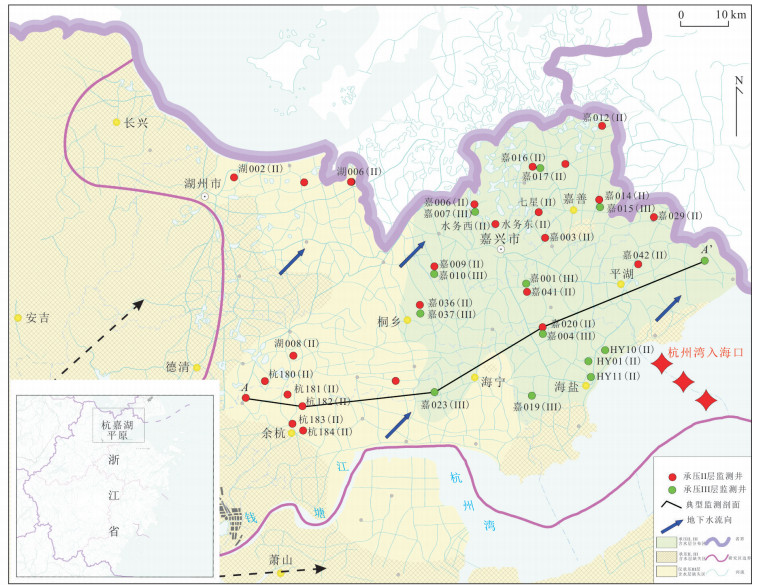
 下载:
下载:

